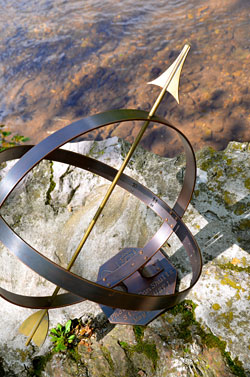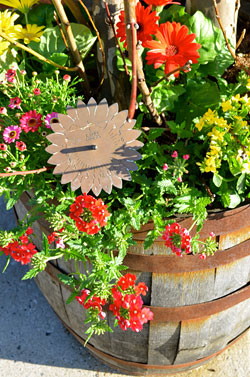Copper Beckons in Armillary Spheres and Shultz Sundials
 John Shultz's armillary spheres are crafted to be especially accurate in time measurements in sunlight.
John Shultz's armillary spheres are crafted to be especially accurate in time measurements in sunlight.Photograph courtesy of Phoebe Canakis
After glimpsing the equation of time in a magazine decades ago, John Shultz became curious about the mathematics of the sundial. Soon, he began making experimental sundials out of wood, stone and plastic and eventually settled on sunflower sundials and armillary spheres out of copper and brass.
“Graphs and tables tend to catch my attention probably more than the average person,” Shultz says. “I’m really a math teacher with a metal shop.” Although he taught math for 34 years, he continued to make sundials, and opened up Shultz Sundials in the early 1990s.
He knew that measuring apparent or true solar time and its relationship to the time we observe on our clocks and watches can be a challenge. Time zones, Daylight saving, as well as latitude and longitude affect the construction, setting and reading of a sundial.
“Very few sundials can be adjusted for where you live,” he explains, noting that most sundials are not really made to tell time.
But Shultz customizes the settings in his pieces to fit the coordinates of the location for those who order his charismatic sunflower sundials and graceful armillary spheres.
And just to make sure the new owners of armillary spheres know how to best appreciate the pieces crafted by Shultz, all orders are accompanied by a 12-page instruction book.
For those in Australia who order sundials from Shultz, the hours go the opposite direction of the versions crafted for homes in the U.S.
Norway is the furthest north he’s created a sundial for in his labors, and people from France and other European countries have requested custom sundials, too.
 These sunflower sundials are something John Shultz sold at the Kutztown Folk Festival for many years in Southeastern Pennsylvania.
These sunflower sundials are something John Shultz sold at the Kutztown Folk Festival for many years in Southeastern Pennsylvania. Photograph courtesy of Phoebe Canakis
Shultz sources his copper from Rancocas Metals Corporation in Rancocas, New Jersey and his brass from Enco in Fernley, Nevada.
Shultz likes the freedom copper and brass give him as an artist, and enjoys the aesthetics these metals bring to his sundials.
“There’s no rust, the oxidizing makes it look nicer, and the shadow is much easier to read,” he says. His armillary spheres are made of rings shaped from copper while the incorporated arrows are made from brass. “And in time, the brass looks black, while the copper looks green,” Shultz says about the coloration lure in the sun-swept pieces.“People who order these like the precision idea involved; a lot appreciate the beauty, but I think around one-third of those who buy them are really interested in telling time.”
Personalized sets of words stretch across the bases of the sundials, with names of homes, pets and anniversary dates as just a few samples of what people ask to have custom-etched into the sundials they order.
Many take the time to send him snapshots of their sundials and armillary spheres in place. In fact, Shultz now keeps a photo album of them all, with hundreds of pictures tucked inside its pages. He’s seen them mounted (often modifying them to mount as the person prefers), used as centerpieces in homes, set on mantels, placed on windowsills, arranged on small tables near entryways and attached to the tops of chimneys aside from just perching outside in people’s yards.
Resources:
Shultz Sundials, Lititz, PA, (717) 575-4048
Also in this Issue:
- Rediscovering the Copper Treasures of The Titanic
- Copper Beckons in Armillary Spheres and Shultz Sundials
- History in Bronze: The Artwork of James E. Kelly
- Ginger Meek Allen: Metalsmith and Ringleader at LEDE Studio And Gallery
- Boxer at Rest Masterpiece of Ancient Bronze Sculpture on Special Loan to Metropolitan Museum
